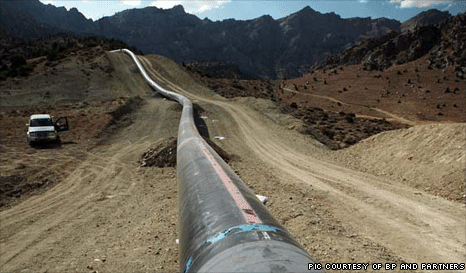IRAN LEAPS TO COMPLETE POTENTIAL GAS EXPORT ROUTES
The Iranian government has announced construction plans for four pipelines at a cost of $12 billion. Of the four planned natural gas pipelines, three will be designed for export and one is aimed at cutting gas imports.
The information portal of Iran’s Oil Ministry reported on January 12th that the government plans to facilitate the construction of the 6th, 9th, and 11th cross-country gas pipelines.
According to Shana News Agency, the 6th and 9th cross-country routes are among the country's projects aimed to export natural gas towards west, including the European Union.
The 11th cross-country pipeline will pump gas from the South Pars gas field towards the northwestern province, Khorasan, to make this region self-sufficient instead of relying on Turkmen gas imports.
Iran has two contracts with Turkmenistan to import 40 million cubic meters of gas per day (mcm/d) and currently imports about 30 mcm/d Turkmen gas.
Iran's plans for the 7th cross-country pipeline include delivery of gas to Pakistan.
The 6 th, 7 th, 9 th, and 11th cross-country gas pipelines, respectively, will requie $2, $2, $6, and $4 billion dollars worth of investments to come on stream.
6th cross-country pipeline
The 6 th cross-country gas pipeline is the first priority, according to Shana. The first and second sections of this pipeline totalling 611 km in length have been completed and 600 km of piping is to reach Iraqi borders.
The capacity of 6th cross-country pipeline is transferring 110 mcm/d of gas to Iraq, Syria, Lebanon and Europe.
Iran has signed two gas export agreements with Iraq to supply 45 mcm/d of gas generated in South Pars to this country.
Iran boosted dry gas production in the South Pars gas field, which shares 30 percent of the country’s 33.6-trillion total gas reserves during 2014 by 80 mcm/d and planed to increase the current level of production in this field by 40 mcm/d until March 2015.
During March 2015 to March 2016, the Iranian government also planned to increase gas production from this field by 100 mcm/d gas.
With completion of South Pars, Iran’s total produced dry gas would double by 2020 compared to the current level, reaching 1.1 billion cubic meters per day.
9th cross-country pipeline
The 9th cross-country gas pipeline is projected to transfer 100 mcm/d of gas towards the north-western borders. The 1,863-kilometers long pipeline has 17 pressure booster stations.
Iran has a contract with Turkey to supply 27 mcm/d of gas, but transferring the country’s gas through Turkey to Europe is the final goal of 9th cross-country pipeline.
The potential route for the delivery of Iranian gas to Turkey and Europe is still uncertain however EU is plans to recieve Azerbaijani gas via the Trans-Adriatic Pipeline (TAP), designed to be connected to the Trans Anatolian Pipeline (TANAP). Initial capacity of TAP is 10 bcm per annum, though Europe recently announced that a doubling of capacity is being considered. TAP is projected to be completed by 2020.
11th cross-country pipeline
The 11th cross-country gas pipeline is 1,100 kilometers long and has the capacity to transfer 100 mcm/d of gas.
Aims to complete the 11th cross-country pipeline that will connect South Pars to north-eastern regions became serious when Turkmenistan cut gas deliveries to Iran in the winter of 2007 due to price disputes with Tehran.
Iran's northern neighbour also declined gas delivery to Iran in 2012 significantly due to Iran’s more than $1 billion debt to Ashgabat brought on by western sanctions on Iran’s banking system.
7th cross-country pipeline
Iran also has a gas transferring project to deliver natural gas to Pakistan. Iran needs $2 billion in investment to be completed, while Pakistan hasn’t started the construction of the pipeline (Peace Pipeline).
Iran and a Russian company recently signed a memorandum of understanding (MoU) on the construction of the 300-kilometer Iranshahr-Chabahar gas pipeline, a part of Peace Pipeline inside Iran.
The final capacity of 7th cross-country pipeline is 110 mcm/d, of which 21 mcm/d is projected to be delivered to Pakistan.
Asghar Soheilipour, an official of National Iranian Gas Company (NIGC) said the diameter of the 240-km-long pipeline is about 56 inches and that of the remaining 60 km is about 36 inches, Shanareported.
Without mentioning the name of the Russian company, he added that it has implemented a large number of important projects.
Construction of 300 km pipeline will cost approximately $700 million and take about two years.
Iran also has a 27 mcm/d gas MoU with Oman, planned to be developed by 2016.
Construction of 300 km pipeline will cost approximately $700 million and take about two years.
Iran also has a 27 mcm/d gas MoU with Oman, planned to be developed by 2016.
Despite an increase in dry gas production by 16 bcm during last nine months, Iran has only been able to increase gas export by 1 bcm due to a sharp rise in domestic consumption.
http://www.naturalgaseurope.com/iran-leaps-to-complete-potential-gas-export-routes


Comments
Post a Comment